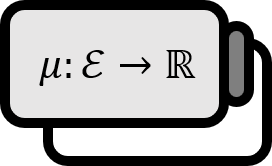Jordan Decomposition Theorem
Theorem
Let’s assume a measurable space $(X,\mathcal{E})$ and a signed measure $\nu$ defined on it. Then, there uniquely exist two positive measures $\nu^{+}$, $\nu^{-}$ that satisfy the following conditions, and $\nu=\nu^{+}-\nu^{-}$ is called the Jordan decomposition of $\nu$.
$$ \nu=\nu^{+}-\nu^{-} $$
If $X=P \cup N$ is called a partition, then $\nu^{+}, \nu^{-}$ is as follows.
$$ \begin{align*} \nu^{+} (E) &= \nu ( E \cap P) \\ \nu^{-}(E) &= -\nu (E \cap N) \end{align*} $$
Proof
Part 1. Existence
Let’s assume a measurable space $(X,\mathcal{E})$ and a signed measure $\nu$ defined on it. Then, according to the partition theorem, there exist the positive set $P$ and the negative set $N$ that satisfy $X=P \cup N$, $P\cap N=\varnothing$ for $\nu$. Let’s define the positive measures $\nu^{+}$, $\nu^{-}$ as follows.
$$ \begin{align*} \nu^{+} (E) &:= \nu (E \cap P) \\ \nu^{-}(E) &:= -\nu (E\cap N) \end{align*} \quad \forall\ E\in\mathcal{E} $$
Then, since $P\cup N=X$, the following is trivially true.
$$ \nu (E)=\nu (E\cap P)+\nu (E \cap N)=\nu^{+} (E) -\nu^{-} (E) $$
Moreover, if $E_{1} \subset P$, $E_2 \subset N$, then every $E_{1}$ is a null set for $\nu^{-}$, and every $E_2$ is a null set for $\nu^{+}$. Therefore, $P$ is $\nu^{-} -\mathrm{null}$, and $N$ is $\nu^{+} -\mathrm{null}$. Hence, $\nu^{+} \perp \nu^{-}$.
Part 2. Uniqueness
Let $\mu^+$, $\mu^-$ be other two positive measures different from $\nu^{+}$, $\nu^{-}$ that satisfy the above.
$$ \nu=\mu^+ - \mu^- $$
And let’s assume two sets that satisfy $E,\ F \in \mathcal{E}$, $\mu^+\perp \mu^-$.
$$ \mu (E\cap N)=\mu^-(E)=0=\mu^+(F)=\mu (F\cap P) $$
$$ E \cup F=X \quad \text{and} \quad E\cap F = \varnothing $$ Due to the above two conditions, it can be seen that $X=E\cup F$ is another partition. Here, $E$ is the positive set, and $N$ is the negative set. Hence, by the partition theorem, $ (P-E)\cup (E-P)$ is a null set for $\nu$. Therefore, for any $A \in \mathcal{E}$, the following holds.
$$ \mu^+(A)=\mu^+ (A\cap E)=\nu (A\cap E)=\nu (A \cap P)=\nu^{+}(A) $$
Similarly, the following formula is valid.
$$ \mu^-(A)=\mu^- (A\cap F)=\nu (A\cap F)=\nu (A \cap N)=\nu^{-}(A) $$
Thus, the two positive measures satisfying the Jordan decomposition theorem are unique.
■
